| University | Coventry University (CU) |
| Subject | PSB501EN: Mechanical Engineering Systems |
Assessment Brief
This document is for CU Group-PSB Academy students for their own use in completing their assessed work for this module and should not be passed to third parties or posted on any website. Any infringements of this rule should be reported to CU_ENG@psb-academy.edu.sg
Introduction:
Engineers apply their knowledge and understanding of various aspects of mechanical engineering (including solid mechanics, fluid mechanics, heat transfer, thermodynamics, etc.) in order to bring about solutions to problems. These solutions, in their very many forms, enhance our quality of life as human beings. It is vital, therefore, that the engineer is not only able to draw upon a wide variety of sound knowledge base, adopt a multidisciplinary approach to problem-solving, but should also be able to document and communicate their findings appropriately. This coursework attempts to take the student through this experience.
Completion of this assignment will address the following learning outcomes:
- MLO1: Evaluate the effects of externally static – or quasi-static – applied load (axial load, torsion, bending moment, and shear) on the internal stress state of structural and machinery components.
- MLO2: Evaluate the principles of Fluid Dynamics (continuity equation, Bernoulli’s equation, integral and differential forms of the conservation equations) and apply them to systems of fluid flow.
- MLO3: Demonstrate comprehension of the laws (Zero, 1st and 2nd) of Thermodynamics and how to apply them to the description of devices operating according to a thermodynamic cycle.
- MLO4: Model and solve problems involving energy balance/heat transfer of any mechanical system.
- MLO5: Examine the fundamentals of Mechanical Vibrations and their role in dynamics of machinery.
- MLO6: Demonstrate capacity to adopt a multi-technique approach to solve problems of mechanical engineering systems and document the procedures accordingly.
Task:
Project: A detailed calculation report for an engineering system and its subsystems. The sheets to be included in the calculation memory refer to each topic of the module. (Equivalent words: 4500).
Students are required to produce a detailed project report on a given engineering project and its subsystems. The project comprises several tasks, and the student will be required to draw upon the breadth and depth of the various subject matters covered during the module. They will also be required to approach problems using a wide variety of techniques. The final project report is completed gradually as the student works through each aspect of the project.
The report may include the following for each task:
- Introduction
- Theory
- Results and discussion
- Conclusion and recommendations
- References list
E.g.: Sample Report Outline:
1.0 Task 1 1.1 Introduction and Theory 1.2 Solution and Discussion 1.3 Reference 2.0 Task 2 2.1 Introduction and Theory 2.2 Solution and Discussion 2.3 Reference
Instruction:
- Answer all tasks. Each task carries equal marks (20 marks), and the total marks for the coursework are 100 marks.
- All solutions should be typed. Marks are not awarded for handwritten work.
- This is an open-book, take-home assignment; you are allowed to use all resources available to you. All references used need to be appropriately cited. APA style (7th edition) reference formatting. You may refer to the CU library guides at https://libguides.coventry.ac.uk/apa
- In a task, some questions may be a continuation of the preceding question.
- In this assignment, the selection of problem parameters depends on your SID. Assume your SID is in the form 𝑋8 𝑋7 𝑋6 𝑋5 𝑋4 𝑋3 𝑋2 𝑋1. From left to right, the first digit is 𝑋8 and the last digit is 𝑋1. If you have any concerns, contact your tutor.
- Select the parameter of the questions based on specified criteria and clearly include these parameters in your report.
Viva Voce Requirement:
Selected reports will undergo a Viva Voce (oral interview) to assess the student’s understanding of the Module Learning Outcomes (MLOs). Students invited for the Viva will be required to explain their approach, justify their solutions, and demonstrate their comprehension of key concepts. Failure to attend the Viva or adequately explain the work submitted may result in further academic review.
Acknowledging the Use of AI Tools:
If you have used any AI tools, such as language models or image recognition software, in your assignment or report, please acknowledge their use in your submission. Include a list of the AI tools used, their purpose in your work, and their source. As part of this requirement, please also include the chat scripts of any AI tools used in your work as an appendix to your submission. This acknowledgement is necessary to ensure academic integrity and transparency in the grading process.
Academic Integrity Guidance:
The best way to avoid academic misconduct is to follow appropriate academic and referencing conventions. Further guidance on academic integrity and conduct can be found using LibGuides at https://libguides.coventry.ac.uk/academicintegrity.
Collusion between students (where sections of your work are similar to the work submitted by other students in this or previous module cohorts) is taken extremely seriously and will be reported to the Academic Conduct Panel. This applies to all coursework and exam answers. If you would like more guidance on understanding collusion, you can find it on LibGuides.
If an assessment suspected of involving a breach of academic integrity is found to display a marked difference in writing style, knowledge and skill level from that demonstrated elsewhere on the course, you may be required to undertake a Viva Voce in order to prove the coursework assessment is entirely your own work.
You must not submit work for an assessment that you have already submitted (partially or in full), either for your current course or for another qualification of this university, unless this is specifically provided for in your assessment brief or specific course or module information. It is important to realise that as a student you should not submit all or part of an assessment for which you have already received academic credit, to be used for an assessment in a different module. Reusing your own work in this way is called self-plagiarism. Where you wish to refer to some of your own work you must reference it in the same way that you reference work by other people.
Please refer to the Marking Rubric for the grading criteria:
I. Knowledge and Understanding (30%)
• Introduction and Theory
II. Analysis, Evaluation and Application of Theory (30%)
• Solution and Discussion
III. Quality of Research (20%)
• All sections
IV. Academic Writing (20%)
• All sections
Project Report Task 01 [25 Marks]
The state of strain at the point on the leaf of the caster assembly is shown in Figure 1. Use the strain transformation equations to determine the equivalent in-plane strains on an element oriented at an angle of 𝜃 = 30° counterclockwise from the original position.
𝜀𝑥 = −50𝑿𝟏 (10−6 ), 𝜀𝑦 = −50𝑿𝟐 (10−6 ), and 𝜀𝑧 = −50𝑿𝟑 (10−6 )
If you have any concerns, contact your tutor.
e.g.: SID is 14486801
𝑋8 𝑋7 𝑋6 𝑋5 𝑋4 𝑋3 𝑋2 𝑋1 1 4 4 8 6 8 0 1 𝜀𝑥 = −50𝟏 × 10−6 , 𝜀𝑦 = −50𝟎 × 10−6 , and 𝜀𝑧 = −50𝟖 × 10−6
Also, use the strain-transformation equations to determine the following:
- The in-plane principal strains.
- Maximum in-plane shear strain.
- Average normal strain.
- Explain the significance of the calculated values.
[12 Marks]
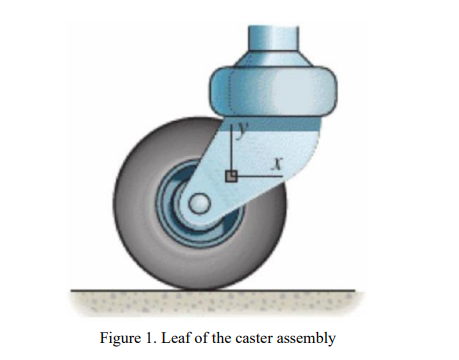
II)You are tasked with designing a pressure vessel. Preliminary measurements of the cylindrical vessel indicate that the normal stresses due to internal pressure are as shown in Figure 2.
- Determine the maximum absolute shear stress in the pressure vessel using an analytical approach. Provide detailed step-by-step manual calculations.
- Determine the principal stresses acting on the pressure vessel using an analytical approach. Show all calculation steps clearly.
- Compare your results with those obtained using an online stress transformation calculator or an applet. Are the answers the same? If not, explain the differences and possible reasons for any discrepancies.

[8 Marks]
Figure 2. Pressure vessel
Project Report Task 02 [25 Marks]
Toluene, an incompressible liquid is one of the fractions (i.e. products) obtained from the distillation column. It is stored temporarily in a tank before it is converted to paint thinners and glue.
Toluene (specific gravity, 0.867) discharges from the bottom of an open tank 1.5 m by 1 m in cross-section. The outlet is equivalent to an orifice 40mm diameter with a discharge coefficient, 𝐶D = 0.60. The liquid level is regulated by a float valve on the toluene feed supply which shuts off completely when the liquid level above the bottom of the tank is 1m and which gives a flowrate which is directly proportional to the distance of the liquid surface below this maximum level. When the depth of toluene in the tank is 0.5 m the inflow and outflow are directly balanced. There is a short interruption in the supply, the toluene level drops to 0.25 m above the bottom of the tank, but is then restored again.
a) Assuming that the area of the orifice is very small in comparison with the area of the pipe, obtain an algebraic expression for the net rate of filling the tank in terms of the distance, ℎ of liquid level below the maximum depth of 1m.
b) Hence or otherwise, obtain an algebraic expression for the time required to fill the tank from 0.25 to 0.45 m above the bottom the tank.
c) Write a MATLAB script or MS EXCEL script to plot the reciprocal of the net rate of filling the tank (obtained in (i)) on the 𝑦-axis against liquid height on the 𝑥-axis.
Estimate the time required to fill the tank from 0.25 to 0.45 m above the bottom of the tank by finding the area under the curve in (iii) within the appropriate limits. You may either write a MATLAB script or use any standard numerical integration technique such as the trapezoidal rule, etc.
Project Report Task 03 [25 Marks]
I)”1. 𝑋4″ kg of air is taken through (a) a Otto cycle (Figure Q3a) and (b) a Diesel cycle (Figure Q3b). Initially, the air is at 25°C and “1. 𝑋4” atm. The compression ratio for both cycles is 12, and the heat added is 1900 kJ in each case. Calculate the ideal cycle efficiency and mean effective pressure for each cycle. Explain in detail the processes mentioned above and the differences between the Otto cycle and diesel cycle using diagrams to buttress your points.
e.g.: SID is 14486801, 𝑋4 = 6, hence the mass of air is 1.6 kg, and the pressure is 1.6 atm.
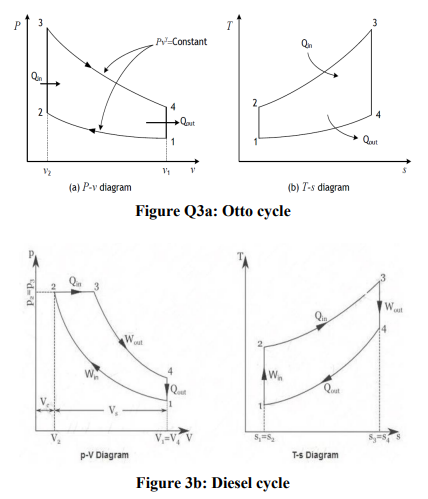
II) A boiler furnace’s vertical walls has a dimension of 5m x 3m x 4m high. The walls are constructed from an inner fire brick wall “3. 𝑋3” cm thick with thermal conductivity of 0.6 W/mK, a layer of ceramic blanket insulation with thermal conductivity 0.3 W/mK and 10 cm thick, and a steel protective layer of thermal conductivity 65 W/mK and 4 mm thick.The inside temperature of the fire bricklayer was measured at 800°C and the temperature of the outside of the insulation was 80 °C. Calculate the heat loss rate through the boiler furnace’s vertical walls. Also, find the interface temperature of layers. Discuss how heat loss can be reduced in the system.
e.g.: SID is 14486801, 𝑋3 = 8, hence the Inner fire brick wall thickness is 3.8 cm.
Project Report Task 04 [25 Marks]
I) Using the APPLET, demonstrate the effect of introducing damping into the system (play with the applet varying the value of the damping constant “c”/”b”) and include an explanation, in your report, of the effect of damping on the frequency of the system and on its amplitude. [4 Marks]
II) In a factory, an engineer discovered that an undamped system vibrates with a frequency of 12 Hz and amplitude 0.8 mm. Calculate the maximum amplitude of the system’s velocity and acceleration. [4 Marks]
III) A boiler furnace’s vertical walls have a dimension of 6m x 4m x 4m high. The walls are constructed from an inner fire brick wall 3. 𝑋3 cm thick with thermal conductivity of 0.6 W/mK, a layer of ceramic blanket insulation with thermal conductivity 0.3 W/mK and 10 cm thick, and a steel protective layer of thermal conductivity 65 W/mK and 4 mm thick. The inside temperature of the fire bricklayer was measured at 800°C and the temperature of the outside of the insulation was 80 °C. Calculate the heat loss rate through the boiler furnace’s vertical walls. Also, find the interface temperature of layers. Discuss how heat loss can be reduced in the system.
e.g.: SID is 14486801, 𝑋3 = 8, hence the Inner fire brick wall thickness is 3.8 cm. [12 Marks]
Note:
- The construction of the document will be explained in details, so as to standardise and allow the creation of a template by the students.
- The use of reference material is strongly encouraged, particularly Codes of practice and Engineering Standards from professional bodies, but not limited to these. Journal papers, books, etc. are also welcome.
Guidance notes and considerations
Late Submission
If you are not able to complete your coursework on time due to extenuating circumstances, the ONLY way to receive an extension (up to 5 working days) or a deferral (anything longer than 5 working days) is to contact a School of Engineering and Technology, PSB Academy.
PSB Academy Singapore – CU_ENG@psb-academy.edu.sg
* Extenuating circumstances are defined by CU as ‘genuine circumstances beyond your control or ability to foresee, and which seriously impair your assessed work’.
* Please note that you will need to provide third party evidence to support your reasoning for requiring an extension or deferral.
* Your course tutor is NOT able to approve an extension or a deferral, if you have not completed the official forms and had your request approved your work will count as not submitted and receive a zero mark.
Plagiarism and Malpractice
- You are encouraged to check the originality of your work by using the draft Turnitin links on your Blackboard Web.
- Collusion between students (where sections of your work are similar to the work submitted by other students in this or previous module cohorts) is taken extremely seriously and will be reported to the academic conduct panel. This applies to all coursework and exam answers.
- A marked difference between your writing style, knowledge and skill level demonstrated in class discussion, any test conditions and that demonstrated in a coursework assignment may result in you having to undertake a Viva Voce in order to prove the coursework assignment is entirely your own work.
- If you make use of the services of a proofreader in your work you must keep your original version and make it available as a demonstration of your written efforts.
- You must not submit work for assessment that you have already submitted (partially or in full), either for your current course or for another qualification of this university, unless this is specifically provided for in your assignment brief or specific course or module information.
- Where earlier work by you is citable, ie. it has already been published/submitted, you must reference it clearly. Identical pieces of work submitted concurrently will also be considered to be self-plagiarism.
Submission Guidelines
There should be a title page which clearly identifies the following;
- Student number
- Name of the module
- Title of the Assessment
- Assessment number
- Word count
The word count identified includes quotations, but excludes the bibliography and unless specifically stated, encompasses a discrepancy of + or – 10%.
Banding
Knowledge and Understanding (30%)
• Introduction and Theory
Analysis, Evaluation and Application of Theory (30%)
• Solution and Discussion
Quality of Research (20%)
• All sections
Academic Writing (20%)
• All sections
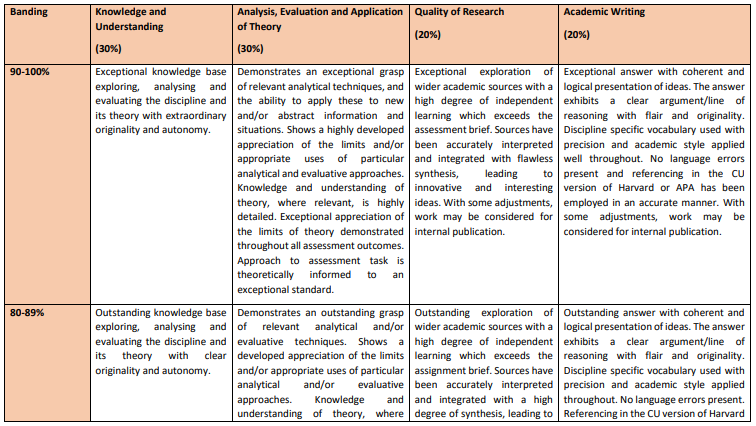
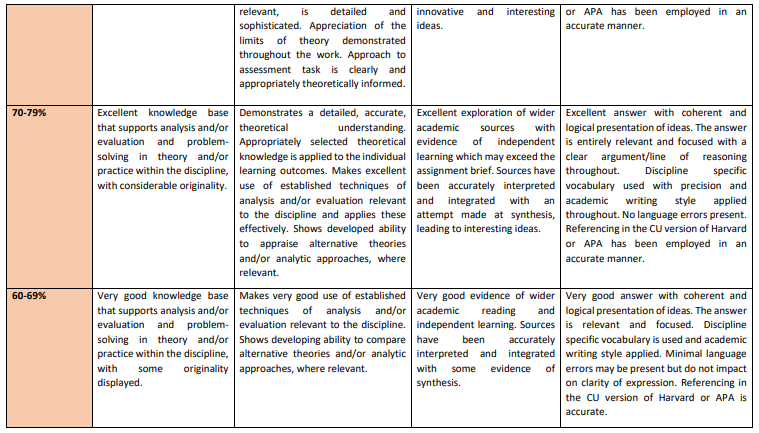
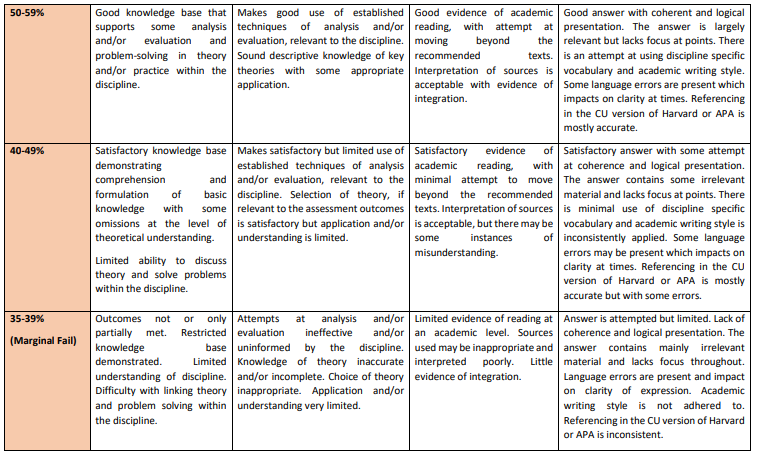

Stuck with a lot of homework assignments and feeling stressed ? Take professional academic assistance & Get 100% Plagiarism free papers
Struggling with your PSB501ENE Engineering Systems Analysis & Design? Well! Stop worrying now. You are at the right place. Our platform provides AI-free SG assignment help. We have experienced writers who provide high-quality, no-plagiarism assignments with 100% original content, and here are free sample assignments that you can look over to see the quality of our work. Contact us right now and get high grades in your academics.
Looking for Plagiarism free Answers for your college/ university Assignments.
- CH2123 Assignnment : Fugacity, VLE Modeling & Henry’s Law Applications
- BAFI1045 Assignment -Constructing and Evaluating Passive and Active Portfolios Based on the Straits Times Index (STI)
- FIN2210E/FIN2212E Group Assignment: Financial Risk Management Analysis of Bursa Malaysia Companies
- FLM101 Assignment: A Cinematic Dissection: Stylistic Elements and Their Thematic Significance
- Assignment: Transforming Talent in the AI Era: From War to Wealth through Ecosystem Innovation
- COMP 1105 Assignment: Health-Focused E-Commerce Website: A Web Technologies Project Using HTML5, CSS, and JavaScript
- Assignment: Machine Learning in Robo-Advisory Services: Evolution, Applications, and Future Trends
- OMGT2229 Assignment: Quantitative Forecasting, Economic Order Analysis, and Strategic Sourcing Decision-Making for JB Hi-Fi
- Assignment 2: Corporate Finance and Planning: An In-Depth Financial Analysis of Company
- BUSM4551 Innovation Management Assignment: Innovation and Its Role in Advancing the UN SDGs


